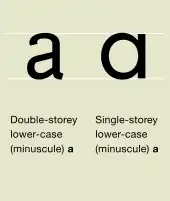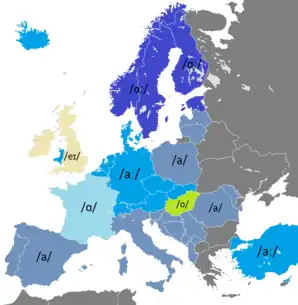A
A, or a, is the first letter and the first vowel of the Latin alphabet,[1][2] used in the modern English alphabet, the alphabets of other western European languages and others worldwide. Its name in English is a (pronounced /ˈeɪ/), plural aes.[nb 1] It is similar in shape to the Ancient Greek letter Alpha, from which it derives.[3] The uppercase version consists of the two slanting sides of a triangle, crossed in the middle by a horizontal bar. The lowercase version can be written in two forms: the double-storey a and single-storey ɑ. The latter is commonly used in handwriting and fonts based on it, especially fonts intended to be read by children, and is also found in italic type.
| A | |
|---|---|
| A a ɑ | |
| Usage | |
| Writing system | Latin script |
| Type | Alphabet |
| Language of origin | Latin language |
| Phonetic usage | |
| Unicode codepoint | U+0041, U+0061 |
| Alphabetical position | 1 |
| History | |
| Development | |
| Time period | ~-700 to present |
| Descendants | |
| Sisters | |
| Other | |
| Other letters commonly used with | a(x), ae, eau, au |
| Writing direction | Left-to-Right |
| ISO basic Latin alphabet |
|---|
| AaBbCcDdEeFfGgHhIiJjKkLlMmNnOoPpQqRrSsTtUuVvWwXxYyZz |
In English grammar, "a", and its variant "an", are indefinite articles.
History
| Egyptian | Proto-Sinaitic | Proto-Canaanite | Phoenician aleph |
Greek Alpha |
Etruscan A |
Latin/ Cyrillic A |
Greek Uncial |
Latin 300 AD Uncial | |
|---|---|---|---|---|---|---|---|---|---|
 |
|||||||||
The earliest known certain ancestor of "A" is aleph (also written 'aleph), the first letter of the Phoenician alphabet,[4] which consisted entirely of consonants (for that reason, it is also called an abjad to distinguish it from a true alphabet). In turn, the ancestor of aleph may have been a pictogram of an ox head in proto-Sinaitic script[5] influenced by Egyptian hieroglyphs, styled as a triangular head with two horns extended.
When the ancient Greeks adopted the alphabet, they had no use for a letter to represent the glottal stop—the consonant sound that the letter denoted in Phoenician and other Semitic languages, and that was the first phoneme of the Phoenician pronunciation of the letter—so they used their version of the sign to represent the vowel /a/, and called it by the similar name of alpha. In the earliest Greek inscriptions after the Greek Dark Ages, dating to the eighth century BC, the letter rests upon its side, but in the Greek alphabet of later times it generally resembles the modern capital letter, although many local varieties can be distinguished by the shortening of one leg, or by the angle at which the cross line is set.
The Etruscans brought the Greek alphabet to their civilization in the Italian Peninsula and left the letter unchanged. The Romans later adopted the Etruscan alphabet to write the Latin language, and the resulting letter was preserved in the Latin alphabet that would come to be used to write many languages, including English.
Typographic variants

During Roman times, there were many variant forms of the letter "A". First was the monumental or lapidary style, which was used when inscribing on stone or other "permanent" media. There was also a cursive style used for everyday or utilitarian writing, which was done on more perishable surfaces. Due to the "perishable" nature of these surfaces, there are not as many examples of this style as there are of the monumental, but there are still many surviving examples of different types of cursive, such as majuscule cursive, minuscule cursive, and semicursive minuscule. Variants also existed that were intermediate between the monumental and cursive styles. The known variants include the early semi-uncial, the uncial, and the later semi-uncial.[6]

 Blackletter A |
Uncial A |
Another Blackletter A |
 Modern Roman A |
 Modern Italic A |
 Modern script A |
At the end of the Roman Empire (5th century AD), several variants of the cursive minuscule developed through Western Europe. Among these were the semicursive minuscule of Italy, the Merovingian script in France, the Visigothic script in Spain, and the Insular or Anglo-Irish semi-uncial or Anglo-Saxon majuscule of Great Britain. By the ninth century, the Caroline script, which was very similar to the present-day form, was the principal form used in book-making, before the advent of the printing press. This form was derived through a combining of prior forms.[6]

15th-century Italy saw the formation of the two main variants that are known today. These variants, the Italic and Roman forms, were derived from the Caroline Script version. The Italic form, also called script a, is used in most current handwriting; it consists of a circle and vertical stroke on the right ("ɑ"). This slowly developed from the fifth-century form resembling the Greek letter tau in the hands of medieval Irish and English writers.[4] The Roman form is used in most printed material; it consists of a small loop with an arc over it ("a").[6] Both derive from the majuscule (capital) form. In Greek handwriting, it was common to join the left leg and horizontal stroke into a single loop, as demonstrated by the uncial version shown. Many fonts then made the right leg vertical. In some of these, the serif that began the right leg stroke developed into an arc, resulting in the printed form, while in others it was dropped, resulting in the modern handwritten form. Graphic designers refer to the Italic and Roman forms as "single decker a" and "double decker a" respectively.
Italic type is commonly used to mark emphasis or more generally to distinguish one part of a text from the rest (set in Roman type). There are some other cases aside from italic type where script a ("ɑ"), also called Latin alpha, is used in contrast with Latin "a" (such as in the International Phonetic Alphabet).
Use in writing systems
English
In modern English orthography, the letter ⟨a⟩ represents at least seven different vowel sounds:
- the near-open front unrounded vowel /æ/ as in pad;
- the open back unrounded vowel /ɑː/ as in father, which is closer to its original Latin and Greek sound;[5]
- the diphthong /eɪ/ as in ace and major (usually when ⟨a⟩ is followed by one, or occasionally two, consonants and then another vowel letter) – this results from Middle English lengthening followed by the Great Vowel Shift;
- the modified form of the above sound that occurs before ⟨r⟩, as in square and Mary;
- the rounded vowel of water;
- the shorter rounded vowel (not present in General American) in was and what;[4]
- a schwa, in many unstressed syllables, as in about, comma, solar.
The double ⟨aa⟩ sequence does not occur in native English words, but is found in some words derived from foreign languages such as Aaron and aardvark.[7] However, ⟨a⟩ occurs in many common digraphs, all with their own sound or sounds, particularly ⟨ai⟩, ⟨au⟩, ⟨aw⟩, ⟨ay⟩, ⟨ea⟩ and ⟨oa⟩.
⟨a⟩ is the third-most-commonly used letter in English (after ⟨e⟩ and ⟨t⟩) and French, the second most common in Spanish, and the most common in Portuguese. About 8.167% of letters used in English texts tend to be ⟨a⟩;[8] the number is around 7.636% in French,[9] 11.525% in Spanish,[10] and 14.634% for Portuguese.[11]
Other languages
In most languages that use the Latin alphabet, ⟨a⟩ denotes an open unrounded vowel, such as /a/, /ä/, or /ɑ/. An exception is Saanich, in which ⟨a⟩ (and the glyph Á) stands for a close-mid front unrounded vowel /e/.
Other systems
In phonetic and phonemic notation:
- in the International Phonetic Alphabet, ⟨a⟩ is used for the open front unrounded vowel, ⟨ä⟩ is used for the open central unrounded vowel, and ⟨ɑ⟩ is used for the open back unrounded vowel.
- in X-SAMPA, ⟨a⟩ is used for the open front unrounded vowel and ⟨A⟩ is used for the open back unrounded vowel.
Other uses
In algebra, the letter a along with various other letters of the alphabet is often used to denote a variable, with various conventional meanings in different areas of mathematics. Moreover, in 1637, René Descartes "invented the convention of representing unknowns in equations by x, y, and z, and knowns by a, b, and c",[12] and this convention is still often followed, especially in elementary algebra.
In geometry, capital A, B, C etc. are used to denote segments, lines, rays, etc.[6] A capital A is also typically used as one of the letters to represent an angle in a triangle, the lowercase a representing the side opposite angle A.[5]
"A" is often used to denote something or someone of a better or more prestigious quality or status: A−, A or A+, the best grade that can be assigned by teachers for students' schoolwork; "A grade" for clean restaurants; A-list celebrities, etc. Such associations can have a motivating effect, as exposure to the letter A has been found to improve performance, when compared with other letters.[13]
"A" is used as a prefix on some words, such as asymmetry, to mean "not" or "without" (from Greek).
In English grammar, "a", and its variant "an", is an indefinite article, used to introduce noun phrases.
Finally, the letter A is used to denote size, as in a narrow size shoe,[5] or a small cup size in a brassiere.[14]
Related characters
Descendants and related characters in the Latin alphabet
- Æ æ : Latin AE ligature
- A with diacritics: Å å Ǻ ǻ Ḁ ḁ ẚ Ă ă Ặ ặ Ắ ắ Ằ ằ Ẳ ẳ Ẵ ẵ Ȃ ȃ Â â Ậ ậ Ấ ấ Ầ ầ Ẫ ẫ Ẩ ẩ Ả ả Ǎ ǎ Ⱥ ⱥ Ȧ ȧ Ǡ ǡ Ạ ạ Ä ä Ǟ ǟ À à Ȁ ȁ Á á Ā ā Ā̀ ā̀ Ã ã Ą ą Ą́ ą́ Ą̃ ą̃ A̲ a̲ ᶏ[15]
- Phonetic alphabet symbols related to A (the International Phonetic Alphabet only uses lowercase, but uppercase forms are used in some other writing systems):
- Ɑ ɑ : Latin letter alpha / script A, which represents an open back unrounded vowel in the IPA
- ᶐ : Latin small letter alpha with retroflex hook[15]
- Ɐ ɐ : Turned A, which represents a near-open central vowel in the IPA
- Λ ʌ : Turned V (also called a wedge, a caret, or a hat), which represents an open-mid back unrounded vowel in the IPA
- Ɒ ɒ : Turned alpha / script A, which represents an open back rounded vowel in the IPA
- ᶛ : Modifier letter small turned alpha[15]
- ᴀ : Small capital A, an obsolete or non-standard symbol in the International Phonetic Alphabet used to represent various sounds (mainly open vowels)
- A a ᵄ : Modifier letters are used in the Uralic Phonetic Alphabet (UPA)[16] (sometimes encoded with Unicode subscripts and superscripts)
- a : Subscript small a is used in Indo-European studies[17]
- ꬱ : Small letter a reversed-schwa is used in the Teuthonista phonetic transcription system[18]
- Ꞻ ꞻ : Glottal A, used in the transliteration of Ugaritic[19]
Derived signs, symbols and abbreviations
- ª : an ordinal indicator
- Å : Ångström sign
- ∀ : a turned capital letter A, used in predicate logic to specify universal quantification ("for all")
- @ : At sign
- ₳ : Argentine austral
- Ⓐ : anarchy symbol
Ancestors and siblings in other alphabets
- 𐤀 : Semitic letter Aleph, from which the following symbols originally derive[20]
- Ա ա : Armenian letter Ayb
Code points
These are the code points for the forms of the letter in various systems
| Preview | A | a | ɑ | |||
|---|---|---|---|---|---|---|
| Unicode name | LATIN CAPITAL LETTER A | LATIN SMALL LETTER A | LATIN SMALL LETTER ALPHA | |||
| Encodings | decimal | hex | dec | hex | dec | hex |
| Unicode | 65 | U+0041 | 97 | U+0061 | 593 | U+0251 |
| UTF-8 | 65 | 41 | 97 | 61 | 201 145 | C9 91 |
| Numeric character reference | A | A | a | a | ɑ | ɑ |
| EBCDIC family | 193 | C1 | 129 | 81 | ||
| ASCII 1 | 65 | 41 | 97 | 61 | ||
- 1 Also for encodings based on ASCII, including the DOS, Windows, ISO-8859 and Macintosh families of encodings.
Other representations
Use as a number
In the hexadecimal (base 16) numbering system, A is a number that corresponds to the number 10 in decimal (base 10) counting.
Notes
- Aes is the plural of the name of the letter. The plural of the letter itself is rendered As, A's, as, or a's.[2]
Footnotes
- "Latin alphabet | Definition, Description, History, & Facts". Encyclopedia Britannica. Archived from the original on 9 March 2021. Retrieved 3 March 2021.
- Simpson & Weiner 1989, p. 1
- McCarter 1974, p. 54
- Hoiberg 2010, p. 1
- Hall-Quest 1997, p. 1
- Diringer 2000, p. 1
- Gelb & Whiting 1998, p. 45
- "Letter frequency (English)". en.algoritmy.net. Archived from the original on 4 March 2021. Retrieved 3 January 2022.
- "Corpus de Thomas Tempé" (in French). Archived from the original on 30 September 2007. Retrieved 15 June 2007.
- Pratt, Fletcher (1942). Secret and Urgent: The story of codes and ciphers. Garden City, NY: Blue Ribbon Books. pp. 254–5. OCLC 795065.
- "Frequência da ocorrência de letras no Português" (in Portuguese). Archived from the original on 3 August 2009. Retrieved 16 June 2009.
- Tom Sorell, Descartes: A Very Short Introduction, (2000). New York: Oxford University Press. p. 19.
- Ciani & Sheldon 2010, pp. 99–100
- Luciani, Jené (2009). The Bra Book: The Fashion Formula to Finding the Perfect Bra. Dallas, TX: Benbella Books. p. 13. ISBN 9781933771946. OCLC 317453115.
- Constable, Peter (19 April 2004), L2/04-132 Proposal to Add Additional Phonetic Characters to the UCS (PDF), archived (PDF) from the original on 11 October 2017, retrieved 24 March 2018 – via www.unicode.org
- Everson, Michael; et al. (20 March 2002), L2/02-141: Uralic Phonetic Alphabet Characters for the UCS (PDF), archived (PDF) from the original on 19 February 2018, retrieved 24 March 2018 – via www.unicode.org
- Anderson, Deborah; Everson, Michael (7 June 2004), L2/04-191: Proposal to Encode Six Indo-Europeanist Phonetic Characters in the UCS (PDF), archived (PDF) from the original on 11 October 2017, retrieved 24 March 2018 – via www.unicode.org
- Everson, Michael; Dicklberger, Alois; Pentzlin, Karl; Wandl-Vogt, Eveline (2 June 2011), L2/11-202: Revised Proposal to Encode "Teuthonista" Phonetic Characters in the UCS (PDF), archived (PDF) from the original on 11 October 2017, retrieved 24 March 2018 – via www.unicode.org
- Suignard, Michel (9 May 2017), L2/17-076R2: Revised Proposal for the Encoding of an Egyptological YOD and Ugaritic Characters (PDF), archived (PDF) from the original on 30 March 2019, retrieved 8 March 2019 – via www.unicode.org
- Jensen, Hans (1969). Sign, Symbol, and Script. New York: G.P. Putman's Sons.
- "Hebrew Lesson of the Week: The Letter Aleph". 17 February 2013. Archived from the original on 26 May 2018. Retrieved 25 May 2018 – via The Times of Israel.
- "Cyrillic Alphabet". Encyclopedia Britannica. Archived from the original on 26 May 2018. Retrieved 25 May 2018.
- Silvestre, M. J. B. (1850). Universal Palaeography. Translated by Madden, Frederic. London: Henry G. Bohn. Archived from the original on 7 May 2021. Retrieved 27 October 2020.
- Frothingham, A. L. Jr. (1891). "Italic Studies". Archaeological News. American Journal of Archaeology. 7 (4): 534. JSTOR 496497. Archived from the original on 18 February 2022. Retrieved 27 October 2020.
- Steele, Philippa M., ed. (2017). Understanding Relations Between Scripts: The Aegean Writing Systems. Oxford: Oxbow Books. ISBN 9781785706479. Archived from the original on 6 May 2021. Retrieved 27 October 2020.
- Fortson, Benjamin W. (2010). Indo-European Language and Culture: An Introduction (second ed.). John Wiley & Sons. ISBN 9781444359688. Archived from the original on 14 August 2021. Retrieved 27 October 2020.
- "𐌰". Wiktionary. Archived from the original on 17 December 2020. Retrieved 25 January 2021.
References
- "English Letter Frequency". Math Explorer's Club. Cornell University. 2004. Archived from the original on 22 April 2014. Retrieved 28 May 2014.
- "Percentages of Letter Frequencies per Thousand Words". Trinity College. 2006. Archived from the original on 25 January 2007. Retrieved 11 May 2015.
- Ciani, Keith D.; Sheldon, Kennon M. (2010). "A Versus F: The Effects of Implicit Letter Priming on Cognitive Performance". British Journal of Educational Psychology. 80 (1): 99–119. doi:10.1348/000709909X466479. PMID 19622200.
- Diringer, David (2000). "A". In Bayer, Patricia (ed.). Encyclopedia Americana. Vol. I: A-Anjou (First ed.). Danbury, CT: Grolier. ISBN 978-0-7172-0133-4.
- Gelb, I. J.; Whiting, R. M. (1998). "A". In Ranson, K. Anne (ed.). Academic American Encyclopedia. Vol. I: A–Ang (First ed.). Danbury, CT: Grolier. ISBN 978-0-7172-2068-7.
- Hall-Quest, Olga Wilbourne (1997). "A". In Johnston, Bernard (ed.). Collier's Encyclopedia. Vol. I: A to Ameland (First ed.). New York, NY: P.F. Collier.
- Hoiberg, Dale H., ed. (2010). "A". Encyclopædia Britannica. Vol. 1: A-ak–Bayes. Chicago, IL: Encyclopædia Britannica, Inc. ISBN 978-1-59339-837-8.
- McCarter, P. Kyle (1974). "The Early Diffusion of the Alphabet". The Biblical Archaeologist. 37 (3): 54–68. doi:10.2307/3210965. JSTOR 3210965. S2CID 126182369.
- Simpson, J. A.; Weiner, E.S.C., eds. (1989). "A". The Oxford English Dictionary. Vol. I: A–Bazouki (2nd ed.). Oxford, UK: Oxford University Press. ISBN 978-0-19-861213-1.
External links
- History of the Alphabet
 Texts on Wikisource:
Texts on Wikisource:
- "A" in A Dictionary of the English Language by Samuel Johnson
- . Encyclopædia Britannica. Vol. I (9th ed.). 1878. p. 1.
- "A". The American Cyclopædia. 1879.
- "A". Encyclopædia Britannica. Vol. I (11th ed.). 1911. p. 1.
- "A". The New Student's Reference Work. 1914.
- "A". Collier's New Encyclopedia. 1921.





